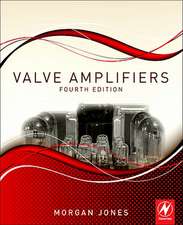Wafer-Level Integrated Systems: Implementation Issues: The Springer International Series in Engineering and Computer Science, cartea 70
Autor Stuart K. Tewksburyen Limba Engleză Hardback – 31 mar 1989
| Toate formatele și edițiile | Preț | Express |
|---|---|---|
| Paperback (1) | 953.03 lei 6-8 săpt. | |
| Springer Us – 9 feb 2012 | 953.03 lei 6-8 săpt. | |
| Hardback (1) | 959.36 lei 6-8 săpt. | |
| Springer Us – 31 mar 1989 | 959.36 lei 6-8 săpt. |
Din seria The Springer International Series in Engineering and Computer Science
- 24%
 Preț: 1041.98 lei
Preț: 1041.98 lei - 20%
 Preț: 643.50 lei
Preț: 643.50 lei - 18%
 Preț: 1225.62 lei
Preț: 1225.62 lei - 18%
 Preț: 965.02 lei
Preț: 965.02 lei - 20%
 Preț: 646.12 lei
Preț: 646.12 lei - 18%
 Preț: 948.79 lei
Preț: 948.79 lei - 20%
 Preț: 646.62 lei
Preț: 646.62 lei - 15%
 Preț: 637.46 lei
Preț: 637.46 lei - 20%
 Preț: 643.83 lei
Preț: 643.83 lei - 18%
 Preț: 949.23 lei
Preț: 949.23 lei - 20%
 Preț: 644.48 lei
Preț: 644.48 lei - 20%
 Preț: 994.92 lei
Preț: 994.92 lei - 20%
 Preț: 645.97 lei
Preț: 645.97 lei - 18%
 Preț: 946.87 lei
Preț: 946.87 lei - 20%
 Preț: 995.57 lei
Preț: 995.57 lei - 18%
 Preț: 956.99 lei
Preț: 956.99 lei - 20%
 Preț: 644.98 lei
Preț: 644.98 lei - 15%
 Preț: 649.54 lei
Preț: 649.54 lei - 18%
 Preț: 950.21 lei
Preț: 950.21 lei - 18%
 Preț: 1221.38 lei
Preț: 1221.38 lei - 18%
 Preț: 957.62 lei
Preț: 957.62 lei - 15%
 Preț: 643.99 lei
Preț: 643.99 lei - 18%
 Preț: 948.47 lei
Preț: 948.47 lei - 18%
 Preț: 947.35 lei
Preț: 947.35 lei - 20%
 Preț: 1284.65 lei
Preț: 1284.65 lei - 20%
 Preț: 1628.31 lei
Preț: 1628.31 lei - 20%
 Preț: 1285.78 lei
Preț: 1285.78 lei
Preț: 959.36 lei
Preț vechi: 1169.95 lei
-18% Nou
Puncte Express: 1439
Preț estimativ în valută:
183.60€ • 190.97$ • 151.57£
183.60€ • 190.97$ • 151.57£
Carte tipărită la comandă
Livrare economică 12-26 aprilie
Preluare comenzi: 021 569.72.76
Specificații
ISBN-13: 9780792390060
ISBN-10: 0792390067
Pagini: 456
Ilustrații: XVI, 456 p.
Dimensiuni: 156 x 234 x 27 mm
Greutate: 0.84 kg
Ediția:1989
Editura: Springer Us
Colecția Springer
Seria The Springer International Series in Engineering and Computer Science
Locul publicării:New York, NY, United States
ISBN-10: 0792390067
Pagini: 456
Ilustrații: XVI, 456 p.
Dimensiuni: 156 x 234 x 27 mm
Greutate: 0.84 kg
Ediția:1989
Editura: Springer Us
Colecția Springer
Seria The Springer International Series in Engineering and Computer Science
Locul publicării:New York, NY, United States
Public țintă
ResearchCuprins
1. Introduction and Overview.- 1.1 Device vs System Scaling.- 1.2 Major Implementation Issues.- 1.3 ESPRIT 824 WSI Program.- References.- 2. Interconnect Issues.- 2.1 Physical Interconnect Hierarchy.- 2.2 Recursive vs Non-Recursive Interconnect Links.- 2.3 On-Chip Interconnect Lengths.- 2.4 Inter-Chip Connection Lengths.- 2.5 Electrical Models of Interconnection Lines.- 2.6 Minimum Line Capacitance.- 2.7 Scaling of On-Chip Interconnections.- 2.8 Chip-to-Board Interconnect Discontinuity.- 2.9 Comparison of Packaging Schemes.- 2.10 Clock Distribution and Clock Skew.- References.- 3. Fabrication Defects.- 3.1 Substrate defects.- 3.2 Lithography-induced defects.- 3.3 Thin Film Defects.- References.- 4. Reliability and Failures.- 4.1 Failure rate modeling.- 4.2 General reliability of IC’s.- 4.3 Failure due to metal electromigration.- 4.4 Failure rates under MOS dimensional and voltage scaling laws.- References.- 5. Yield models and Analysis.- 5.1 General yield models.- 5.2 Early yield models.- 5.3 General IC yield models.- 5.4 VLSI yield models based on yield observations.- 5.5 Defect size distributions and critical areas.- 5.6 Yield simultion in VLSI CAD tools.- 5.7 Appendix.- References.- 6. Fault Modeling.- 6.1 General fault modeling issues.- 6.2 Definitions.- 6.3 Stuck-at faults and weak 0/1 faults.- 6.4 “Stuck” transistor faults.- 6.5 Bridging faults.- 6.6 Metastability in latches and flip-flops.- References.- 7. General testing techniques.- 7.1 General Test issues.- 7.2 Scan path test design.- 7.3 LSSD-based Test Methodologies.- 7.4 Pseudorandom test pattern generators.- 7.5 Test response compression.- References.- 8. Function-Specific Testing.- 8.1 Memory testing.- 8.2 Built-in testing of regular arrays.- 8.3 Testable programmable logic arrays.- References.- 9.Physical Restructuring.- 9.1 General Restructuring Techniques.- 9.2 Laser “zapping” for memory repair.- 9.3 Electronically field-programmable anti-fuses.- 9.4 Laser-assisted chemical processing.- 9.5 Focussed ion beams for restructuring.- 9.6 Electron beam restructuring.- 9.7 Restructurable VLSI program.- References.- 10. Programmable Electronic Reconfiguration Switches.- 10.1 General switching issues.- 10.2 Reconfigurable processors.- 10.3 WASP (The WAfer-scale Systolic Processor).- 10.4 Representative switch configurations.- 10.5 Non-lattice reconfiguration switch organizations.- References.- 11. Formal Models of Reconfiguration.- 11.1 Introduction.- 11.2 Probabilistic bounds: Linear arrays.- 11.3 Probabilistic bounds: 2-dimensional arrays.- 11.4 The Diogenes approach of Rosenberg.- 11.5 Self-reconfiguration algorithms.- 11.6 Spare roow/column allocation algorithms.- References.- 12. Silicon Wafer Hybrids.- 12.1 Introduction.- 12.2 Wafer transmission module.- 12.3 AVP modules.- 12.4 Programmable hybrid wafer circuits.- 12.5 MicroChannel cooling and chip attachment.- 12.6 Microwave performance issues.- 12.7 Chip Templates.- 12.8 Other Silicon Circuit Board Studies.- References.- 13. Optical Interconnections.- 13.1 optical interconnects.- 13.2 Optical Interconnect Components.- References.
















